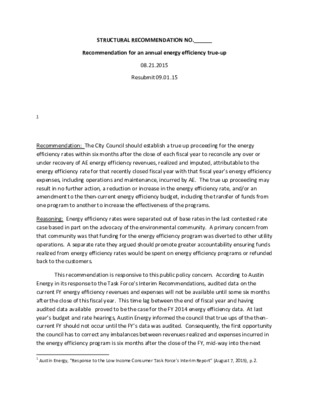Item 3d-Recommendation for an Annual Energy Efficiency True-up_Lanetta Cooper — original pdf
Backup

STRUCTURAL RECOMMENDATION NO.______ Recommendation for an annual energy efficiency true-up 08.21.2015 Resubmit 09.01.15 1 Recommendation: The City Council should establish a true up proceeding for the energy efficiency rates within six months after the close of each fiscal year to reconcile any over or under recovery of AE energy efficiency revenues, realized and imputed, attributable to the energy efficiency rate for that recently closed fiscal year with that fiscal year’s energy efficiency expenses, including operations and maintenance, incurred by AE. The true up proceeding may result in no further action, a reduction or increase in the energy efficiency rate, and/or an amendment to the then-current energy efficiency budget, including the transfer of funds from one program to another to increase the effectiveness of the programs. Reasoning: Energy efficiency rates were separated out of base rates in the last contested rate case based in part on the advocacy of the environmental community. A primary concern from that community was that funding for the energy efficiency program was diverted to other utility operations. A separate rate they argued should promote greater accountability ensuring funds realized from energy efficiency rates would be spent on energy efficiency programs or refunded back to the customers. This recommendation is responsive to this public policy concern. According to Austin Energy in its response to the Task Force’s Interim Recommendations, audited data on the current FY energy efficiency revenues and expenses will not be available until some six months after the close of this fiscal year. This time lag between the end of fiscal year and having audited data available proved to be the case for the FY 2014 energy efficiency data. At last year’s budget and rate hearings, Austin Energy informed the council that true ups of the then-current FY should not occur until the FY’s data was audited. Consequently, the first opportunity the council has to correct any imbalances between revenues realized and expenses incurred in the energy efficiency program is six months after the close of the FY, mid-way into the next 1 Austin Energy, “Response to the Low Income Consumer Task Force’s Interim Report” (August 7, 2015), p.2. year’s FY’s operations. A true up proceeding at this time would provide up to date adjustments to the then current FY EE programs and/or rates in a timely manner. Without this true-up the regulatory risk increases that funds collected with EE rates are spent elsewhere in the utility’s operations and not on the EE programs.